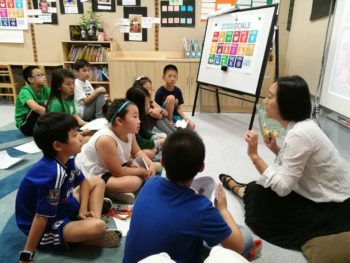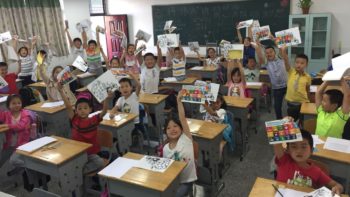
Children enjoy fairy tales that allow them to use their imagination to make sense of the world. ACT member Amity Foundation is working with children in Nanjing, China on a journey towards understanding and achieving the Sustainable Development Goals (SDGs).
The storybook “Fairy Tales for a Fairer World” is a collection of fairy tales popular to various regions of the world. It is a tool that was developed by the United Nations for children and adults to learn about the SDGs. The stories have been adapted from their original fairy tale to highlight some of the most significant global challenges to sustainable development that are faced by humanity today including hunger, human rights, discrimination, education, women’s empowerment, migration, species extinction and climate change. Stories of Rapunzel, Snow White, Little Red Riding hood, Aladdin and other heroes and heroines are depicted as elderly citizens living in a home together, struggling to make a positive change in the world. The stories provide an opportunity for children and adults to learn about the SDGs and some of the initiatives that are taking place around the world to achieve them.
Using this tool, Amity Foundation has worked with over three hundred young students from five local schools to read, discuss, and to translate the fairy tale within their cultural contexts. Through this experience, children have been able to use their imagination to capture a glimpse of what the world could look like in the future.
As children have a key role to play in the future of the world, the international community has put their hope in them to achieve the SDGs. Explaining the significance of the SDGs to children and preparing them for the future world is a demanding task, however, the journey to achieving the SDGs will require for them to be exposed to real problems so that they can be involved in solving them. Amity Foundation is proud to play a role in this journey and to be able to touch the vivid minds of children while accompanying them through the difficulties that they may face.

Below are some of the questions that were asked to the children during their discussions with Amity Foundation, and their responses. While some of the responses reflect a sense of hope for the future and are indicative of the interest of children to be active participants for a more sustainable world, other responses reflect fear and discouragement. Amity Foundation will continue to work with children to better prepare them to deal with some of the difficulties and realities of achieving the SDGs, and to equip them to be active and hopeful participants in this journey.
What will our world be like in 2030?
“The earth will be destroyed”; “I’m going to be happy”; “We will have blue sky”; “I will be jobless”; “We are going to have war”; “I want to go to the US, oh I want to go to the moon!”
Do you agree that the SDGs could be actualised? Could we make it so that all children no longer suffer from hunger and war?
“No. It’s not possible. There is too much inequality. It can never change”; “Yes! My father works at the Environmental Protection Agency”; “We can! I won’t litter.”
The actions of adults may impact what your future would will look like. Could you request your parents to take responsibility for their actions?
“Yes, we can”; “If you say this to your father, he will probably get angry”; “My mom works for the bank. Her work is not related to us.”